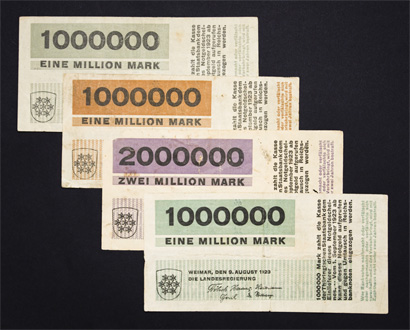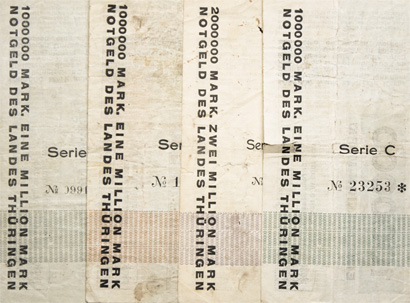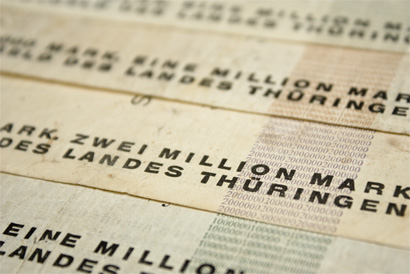In 1923 the German economy was devastated by World War I and reparations made for rampant inflation. Hyperinflation set in and, as prices rose exponentially, common currency became worthless. To meet the demand, paper notes were printed almost nightly in every region, jumping from thousands to millions to billions. These marks are known as notgeld, or “emergency money.” In a normal economy currency design says little about social climate and nothing about individual opinion, but notgeld gave designers a platform at a volatile time.
The design of most notgeld, particularly in rural areas, drew on historic messages and heraldic imagery, slipping quickly into romanticized nationalism, and ultimately the seeds of Blut und Boden (examples can be found on flickr). The typography drew heavily on the past with blackletter and elaborate scripts. National iconography was rendered in any manner from delirious flourish to self-righteous idealizations in colors either dreary or fiery. The values of many of these bills — up to 100 trillion marks — were often written long-hand, sometimes without digits at all.
These sentiments of blind nationalism, catalyzed by visual language, would ultimately be adopted and manipulated by Nazi leadership. Indeed, the design of notgeld serves as documentation of the prevailing attitudes in pre-Nazi Germany. One series of notgeld, however, shows a different allegiance.
At just 23 years of age, Herbert Bayer was called upon to design a series of notgeld for Thuringia, a liberal stronghold and then capital of Germany. Virtually overnight (accounts vary from one to three days), Bayer created a full range of bank-notes. The results are stunning examples of modernist design, shining the light of rational thinking forward rather than seeking comfort in the past.
Front.
Front, detail.
Clarity and immediacy are the first priority of the system. The typography — selected from whatever the printer had on hand — is dominated by sans-serif. In big, beautiful arabic numerals the value of each note is the most prominent element, awash in a field of optimistic color, reprising rather playfully as patterning on each side. The content is blocked in an orderly grid, rotating 90° to allow the text to fit naturally, given the form.
Socialist, nationalist, or protectionist imagery? None.
The only non-typographic element present is a modestly scaled crest of the Weimar Republic, with the sole functional purpose to serve as the official seal. No other work in the canon of modernist design so clearly delivers on the principles of Bauhaus modernism: honesty, functionality, and beauty.
Back.
Back, detail.
It is said that the moment these bills were printed, they were best used as wallpaper, as they immediately lost their value. Their worth, however, was intrinsic and timeless; a message of promise in hard times, innovation over regression, the modernist ethos over wanton pathos.
Aaron is a partner at design office Objective Subject in Brooklyn and writes for The Scout. Written with thanks to Erik Marinovich and David Jalbert-Gagnier.










Brilliant writing, brilliant photos, brilliant subject matter - thanks for this!
On Mar.05.2009 at 01:00 PM